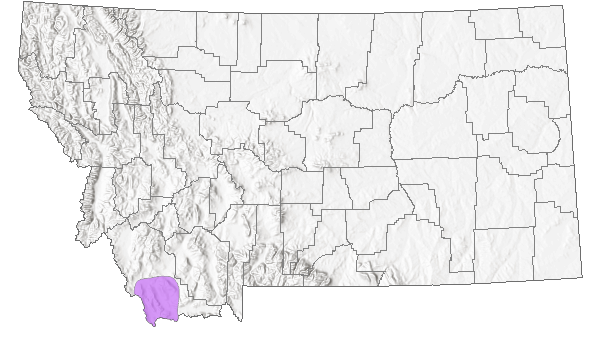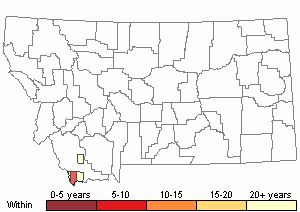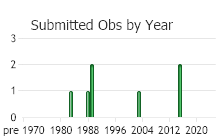View in other NatureServe Network Field Guides
NatureServe
Montana
Utah
Wyoming
Idaho
Wisconsin
British Columbia
South Carolina
Yukon
California
New York
Idaho Fleabane - Erigeron asperugineus
State Rank Reason (see State Rank above)
Idaho fleabane is a regional endemic that has been documented from a few locations in Montana. It grows in alpine habitats, which tend to be relatively isolated from anthropogenic disturbance. Updated population data are needed for most occurrences and it is likely that a few additional occurrences will be documented.
General Description
Idaho Fleabane is a small perennial herb that is 2-20 cm tall. It has 1 to a few stems arising from a slender taproot. The basal leaves are up to 10 cm long, and have a broadly lance-shaped to nearly round blade and a long petiole. The few stem leaves are smaller and reduced upwards. The herbage is densely covered with short spreading hairs. The daisy-like, flowering heads are solitary (or, occasionally, there are 2) at the ends of the stalks. The involucral bracts are 5-9 mm long and covered with glands and spreading hairs. The 10-25 deep blue or violet rays that compose the petals of the flowering head are 5-10 mm long. The disk corollas in the center of the head are 4-6 mm long. The achenes have 20-30 bristles, forming a pappus, at their tops.
Phenology
Flowering occurs in July-August.
Diagnostic Characteristics
There are many species of high-elevation, low-growing, taprooted Erigeron, and it is difficult to distinguish among them. Erigeron evermannii and E. leiomerus have glabrous leaves. Hair on the stems of E. tweedyi and E. tener is appressed rather than spreading outward. The larger leaves of E. caespitosus have three nerves, while those of E. asperugineus have only one. Leaves of E. radicatus, E. ochroleucus and E. rydbergii are nearly linear; the petiole not distinguishable from the blade.
Species Range
Montana Range
Range Descriptions

 Native
Native
Range Comments
Central ID, northeast NV, and southwest MT. Regional endemic.
Observations in Montana Natural Heritage Program Database
Number of Observations: 7
(Click on the following maps and charts to see full sized version)
Map Help and Descriptions
Relative Density

Recency



 (Observations spanning multiple months or years are excluded from time charts)
(Observations spanning multiple months or years are excluded from time charts)
Habitat
The species typically grows on windswept, rocky or gravelly slopes and ridges in alpine zones, often on limestone-derived soils. Associates that have been documented at Montana sites include Agropyron spicatum (dominant with cushion plants at one locality), Haplopappus acaulis, Phlox mulitflora, Arenaria congesta, Erigeron compositus, Senecio canus, Bupleurum americanum and Antennaria umbrinella.
Ecological Systems Associated with this Species
- Commonly Associated with these Ecological Systems
Alpine Systems
Ecology
Erigeron asperugineus is a low-growing plant, easily shaded by taller plants. It always occurs in sparse vegetation. One collection (possibly misidentified) from the 1960's referred to its habitat as "overgrazed."
POLLINATORS The following animal species have been reported as pollinators of this plant species or its genus where their geographic ranges overlap:
Bombus bifarius,
Bombus centralis,
Bombus fervidus,
Bombus flavifrons,
Bombus huntii,
Bombus melanopygus,
Bombus mixtus,
Bombus rufocinctus,
Bombus occidentalis, and
Bombus insularis (Thorp et al. 1983, Wilson et al. 2010, Colla and Dumesh 2010, Koch et al. 2012).
Management
The alpine habitat of E. asperugineus is at low risk from anthropogenic disturbance; however there are very few recent records, so it is difficult to make inferences about its status.
Stewardship Responsibility
Threats or Limiting Factors
STATE THREAT SCORE REASON
Threat impact not assigned because threats are not known (MTNHP Threat Assessment 2021).
References
- Literature Cited AboveLegend:
 View Online Publication
View Online Publication Colla, S.R. and S. Dumesh. 2010. The bumble bees of southern Ontario: notes on natural history and distribution. Journal of the Entomological Society of Ontario 141:39-68.
Colla, S.R. and S. Dumesh. 2010. The bumble bees of southern Ontario: notes on natural history and distribution. Journal of the Entomological Society of Ontario 141:39-68. Koch, J., J. Strange, and P. Williams. 2012. Bumble bees of the western United States. Washington, DC: USDA Forest Service, Pollinator Partnership. 143 p.
Koch, J., J. Strange, and P. Williams. 2012. Bumble bees of the western United States. Washington, DC: USDA Forest Service, Pollinator Partnership. 143 p. MTNHP Threat Assessment. 2021. State Threat Score Assignment and Assessment of Reported Threats from 2006 to 2021 for State-listed Vascular Plants. Botany Program, Montana Natural Heritage Program, Helena, Montana.
MTNHP Threat Assessment. 2021. State Threat Score Assignment and Assessment of Reported Threats from 2006 to 2021 for State-listed Vascular Plants. Botany Program, Montana Natural Heritage Program, Helena, Montana. Thorp, R.W., D.S. Horning, and L.L. Dunning. 1983. Bumble bees and cuckoo bumble bees of California (Hymenoptera: Apidae). Bulletin of the California Insect Survey 23:1-79.
Thorp, R.W., D.S. Horning, and L.L. Dunning. 1983. Bumble bees and cuckoo bumble bees of California (Hymenoptera: Apidae). Bulletin of the California Insect Survey 23:1-79. Wilson, J.S., L.E. Wilson, L.D. Loftis, and T. Griswold. 2010. The montane bee fauna of north central Washington, USA, with floral associations. Western North American Naturalist 70(2): 198-207.
Wilson, J.S., L.E. Wilson, L.D. Loftis, and T. Griswold. 2010. The montane bee fauna of north central Washington, USA, with floral associations. Western North American Naturalist 70(2): 198-207.
- Additional ReferencesLegend:
 View Online Publication
View Online Publication
Do you know of a citation we're missing? Lesica, P., M.T. Lavin, and P.F. Stickney. 2012. Manual of Montana Vascular Plants. Fort Worth, TX: BRIT Press. viii + 771 p.
Lesica, P., M.T. Lavin, and P.F. Stickney. 2012. Manual of Montana Vascular Plants. Fort Worth, TX: BRIT Press. viii + 771 p. Lesica, P., M.T. Lavin, and P.F. Stickney. 2022. Manual of Montana Vascular Plants, Second Edition. Fort Worth, TX: BRIT Press. viii + 779 p.
Lesica, P., M.T. Lavin, and P.F. Stickney. 2022. Manual of Montana Vascular Plants, Second Edition. Fort Worth, TX: BRIT Press. viii + 779 p.
- Web Search Engines for Articles on "Idaho Fleabane"





